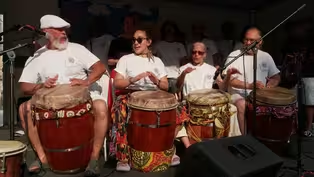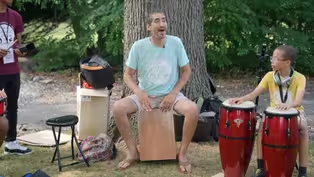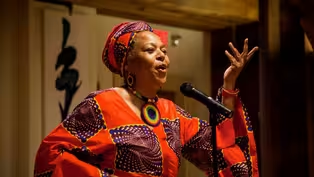State of the Arts
Korean Dance & Drums: Lena Mija Kim
Clip: Season 43 Episode 3 | 5m 32sVideo has Closed Captions
Lena Mija Kim, a master of Korean dance, passes the art form down to the next generation.
A master of centuries-old Korean dance, Lena Mija Kim is an acclaimed, award-winning performer from South Korea. Now in her mid-70s, Lena is one of the last masters of traditional Korean dance. Her daughter Elle, along with teachers and dancers from around the world, flock to her studio in Palisades Park, NJ, to study with her and pass the art form and its traditions to the next generation.
Problems playing video? | Closed Captioning Feedback
Problems playing video? | Closed Captioning Feedback
State of the Arts is a local public television program presented by NJ PBS
State of the Arts
Korean Dance & Drums: Lena Mija Kim
Clip: Season 43 Episode 3 | 5m 32sVideo has Closed Captions
A master of centuries-old Korean dance, Lena Mija Kim is an acclaimed, award-winning performer from South Korea. Now in her mid-70s, Lena is one of the last masters of traditional Korean dance. Her daughter Elle, along with teachers and dancers from around the world, flock to her studio in Palisades Park, NJ, to study with her and pass the art form and its traditions to the next generation.
Problems playing video? | Closed Captioning Feedback
How to Watch State of the Arts
State of the Arts is available to stream on pbs.org and the free PBS App, available on iPhone, Apple TV, Android TV, Android smartphones, Amazon Fire TV, Amazon Fire Tablet, Roku, Samsung Smart TV, and Vizio.
Providing Support for PBS.org
Learn Moreabout PBS online sponsorship♪♪ ♪♪ [ Speaking native language ] -I'm originally from Pohang, South Korea.
I was introduced to dance at the age of five when my mom took me to my first dance class.
I fell in love right away and attended performance schools and simply loved it.
-Lena Kim was very renowned, one of the most respected and popular Korean folk dancers.
-In Korea, my grandma is really famous.
I think she's a great dancer and she inspires many Korean people in the nation and in Korea.
[ Speaking native language ] -For me, there was always a fire inside me.
A lot of people do call me tiger mom, tiger teacher.
[ Drumming ] Always challenging myself to do something, something more difficult, something that's not attainable.
But for me, that only makes the fire burn more.
[ Speaking native language ] -So in 1967, I was able to receive the National Performance Award while I was just in my middle school.
1972 was the first time that I received recognition for my hunchback dance.
-[Narrator 2] Lena Kim was an acclaimed master of traditional dance in South Korea when she immigrated to the United States in 1982.
She was in her early 30s.
She then spent years working at a Korean fish market and a grocery store in the Bronx.
In 2014, Lena returned to Korea and began to dance again.
It had been more than 30 years.
[ Speaking native language ] -Even though it's been 30 years, my body definitely was older, but my insight, the passion, the dream, the fire inside me was burning throughout those 30 years, and all I wanted to do was just get back on stage and dance again.
-[Narrator 2] Now, dancers and teachers from throughout the U.S. and abroad come to study with Lena at her studio in Palisades Park, New Jersey.
-Palisades Park -- The economy wasn't doing too good during the '80s.
Korean Americans saw this opportunity, came here to start to rebuild it again.
And this is what you see right now.
About 65% are Korean Americans or descendants.
-[Narrator 2] Lena performed at the town's Korean Arts in Motion festival.
♪♪ ♪♪ ♪♪ -She is one of the last masters now because she is in her mid 70s, so the masters that taught her are all gone now.
She is very sad that it might die with her.
Her dream is to give it to me.
She wants me to learn it so that I could pass it on to the next generation.
She's been asking me for years, and I've been saying, "That's a ridiculous dream.
I have no idea what you're doing.
I mean, seriously, give it to someone who knows what they're doing."
But there's a few lessons with her.
I feel that fire that she's talking about, so we're considering it now.
[ Drumming ] The dance is called Koban Nam-Moo Dance, originally performed mostly for the kings and nobles of Joseon Dynasty, starting back in 1300s.
It's considered one of the most glamorous dances, and it has its artistry with culture and refinement.
[ Speaking native language ] -The reason why I see Koban Nam-Moo Dance being different than any other dance, goes back generations from the early stages from when Korea was first formed.
There's a word in Korea called "Han."
If you translate it into English, it's just simply soul, but it doesn't do a full translation because Han itself embodies the soul going through all the different emotions such as sadness, joy, wisdom.
And Korean traditional dance embodies Han, that soul.
♪♪ ♪♪
Bomba y Plena: Juan Cartagena & Nanette Hernández
Video has Closed Captions
Clip: S43 Ep3 | 6m 29s | Juan Cartagena and Nanette Hernández blend social justice with Puerto Rican Bomba y Plena. (6m 29s)
Peruvian Cajon Player: Hector Morales
Video has Closed Captions
Clip: S43 Ep3 | 5m 24s | Hector Morales brings traditional Afro-Peruvian music to the U.S. from Lima, Peru. (5m 24s)
Video has Closed Captions
Clip: S43 Ep3 | 6m 36s | Queen Nur shares her ancestral history and preserves African culture through storytelling. (6m 36s)
Providing Support for PBS.org
Learn Moreabout PBS online sponsorshipSupport for PBS provided by:
State of the Arts is a local public television program presented by NJ PBS


















